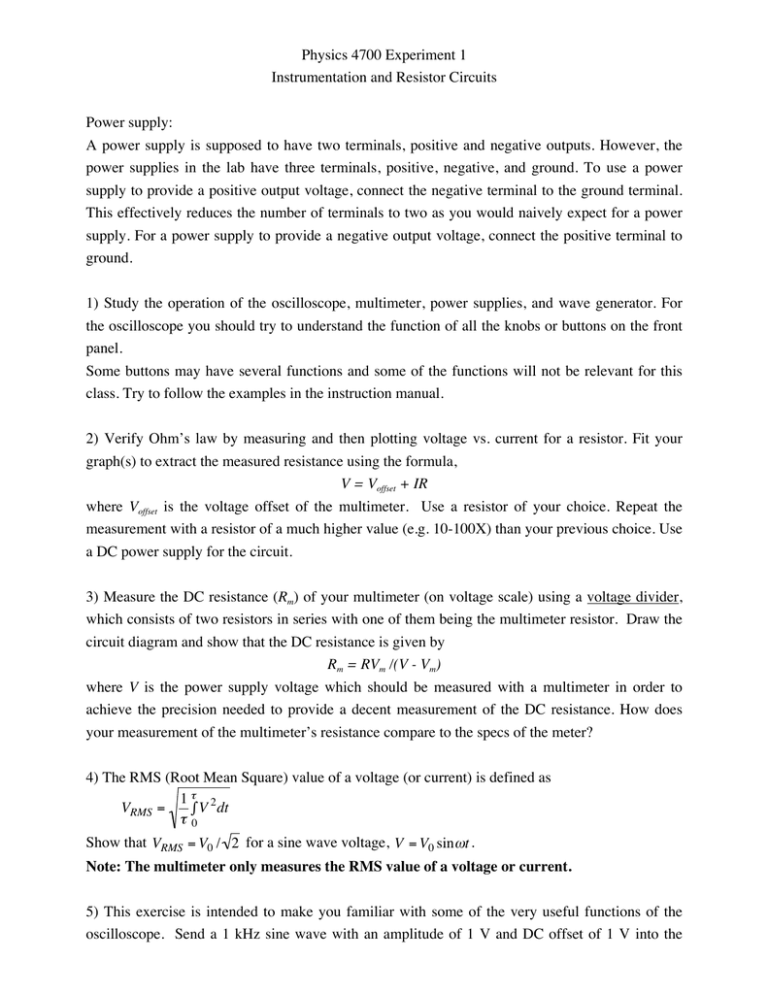Lab 1 - Physics
advertisement

Physics 4700 Experiment 1 Instrumentation and Resistor Circuits Power supply: A power supply is supposed to have two terminals, positive and negative outputs. However, the power supplies in the lab have three terminals, positive, negative, and ground. To use a power supply to provide a positive output voltage, connect the negative terminal to the ground terminal. This effectively reduces the number of terminals to two as you would naively expect for a power supply. For a power supply to provide a negative output voltage, connect the positive terminal to ground. 1) Study the operation of the oscilloscope, multimeter, power supplies, and wave generator. For the oscilloscope you should try to understand the function of all the knobs or buttons on the front panel. Some buttons may have several functions and some of the functions will not be relevant for this class. Try to follow the examples in the instruction manual. 2) Verify Ohm’s law by measuring and then plotting voltage vs. current for a resistor. Fit your graph(s) to extract the measured resistance using the formula, V = Voffset + IR where Voffset is the voltage offset of the multimeter. Use a resistor of your choice. Repeat the measurement with a resistor of a much higher value (e.g. 10-100X) than your previous choice. Use a DC power supply for the circuit. 3) Measure the DC resistance (Rm) of your multimeter (on voltage scale) using a voltage divider, which consists of two resistors in series with one of them being the multimeter resistor. Draw the circuit diagram and show that the DC resistance is given by Rm = RVm /(V - Vm) where V is the power supply voltage which should be measured with a multimeter in order to achieve the precision needed to provide a decent measurement of the DC resistance. How does your measurement of the multimeter’s resistance compare to the specs of the meter? 4) The RMS (Root Mean Square) value of a voltage (or current) is defined as 1τ 2 VRMS = ∫ V dt τ0 Show that VRMS = V0 / 2 for a sine wave voltage, V = V0 sin ωt . Note: The multimeter only measures the RMS value of a voltage or current. € € familiar with some of the very useful functions of the € This exercise is intended to make you 5) oscilloscope. Send a 1 kHz sine wave with an amplitude of 1 V and DC offset of 1 V into the scope. Use DC coupling between the scope and the function generator (See the instruction manual for definitions of DC and AC couplings. Push the CH1 or CH2 MENU button to select the desirable coupling from the menu.) a) Calculate the expected RMS voltage. b) Use the “MEASURE” button to measure the following quantities: mean, RMS voltage, peak-topeak voltage, period, and frequency. Do the measured quantities agree with the expectations? c) Use the “CURSOR” button to position the two cursors to measure the peak-to-peak voltage and period. Do the measured quantities agree with the expectations? d) Measure the RMS voltage with an AC coupling between the scope and the function generator. Does the measured RMS voltage agree with the expectation? 6) Repeat part 2) using a 10 Hz (or as low frequency as practical) sine wave. Repeat measurements using a much higher (e.g. 1 kHz) frequency sine wave. Any frequency dependence for R? Note: Use a multimeter for the current measurement and an oscilliscope for the voltage measurement. All of our multimeters measure current and voltage over a limited frequency range. Check the spec sheet for your meter's usable frequency range. 7) Design and build a circuit with the following specs: a) four or more different resistors b) resistors in series and parallel c) circuit draws between 10 and 50 milliamps when connected to 5 V DC. Calculate and measure the voltage drop and current through each element in the circuit. 8) Use the oscilloscope to check the frequency calibration of your function generator. Start at about 10 Hz and go up to the highest frequency available. Present your results in a log-log plot. Fit the plot to a straight line, f = foffset + cf0 How is your measured c compared to the value expected for an ideal function generator? Optional Advanced Experiment (10 points) 1) Measure the input impedance of your oscilloscope. Determine the effective values of R and C and compare with the scope’s specs. Use a resistor divider to measure R and a capacitor divider to measure C.




